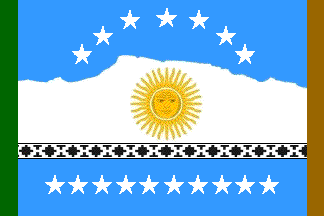
Last modified: 2024-01-06 by rob raeside
Keywords: sarmiento department | chubut province | argentina |
Links: FOTW homepage |
search |
disclaimer and copyright |
write us |
mirrors
 image
by Ivan Sache, 1 October 2012
image
by Ivan Sache, 1 October 2012
The municipality of Sarmiento (8,028 inhabitants in 2001) is located in the extreme south of the Chubut Province (Patagonia), 160 km east of Comodoro Rivadavia. Founded on 21 January 1897 as a Welsh colony and, therefore, one of the oldest towns in Patagonia, Sarmiento is the capital of the Department of the same name (14,563 sq. km). Sarmiento is the closest town to the "Bosque Petrificado Josť Ormachea" (Petrified Forest Josť Ormachea), the biggest fossil forest in the world.
The town, formerly known as Colonia Sarmiento, was named for Domingo Faustino Sarmiento (1811-1888), President of the Republic in 1868-1874.
The flag is modelled on the Argentine national flag, the white stripe being shaped like Mt. San Bernardo, the geographic identification of the town. The white stripe is separated from the lower celeste blue flag by a "Tehuelche guard", black with X-shaped white elements, recalling the native peoples who already lived there 12,000 years ago.
The 17 white stars (seven forming an arch in the upper part of the flag, another ten forming a horizontal line in the lower part of the flag) represent the 17 settlements at the origin of Sarmiento and the melting pot constituted by the town.
Along the hoist, a green vertical stripe represents the fertile valley surrounding the town; along the fly, a brown vertical stripe
represents the Patagonian steppe. The two "guards" located on both ends of the flag are a symbol of protection, modelled on the concept of the protection halo provided by the gods shown on the natives' cloth.
The flag is hoisted in the room of the Municipal Council, together with the flags of Argentina and of the Chubut Province. It is also used outdoors in official ceremonies.
Ivan Sache, 1 October 2012